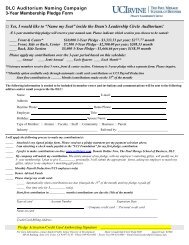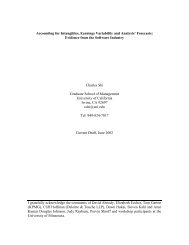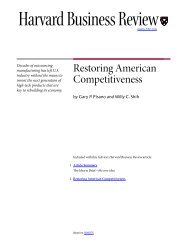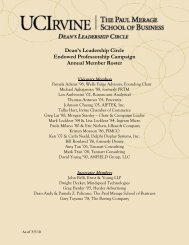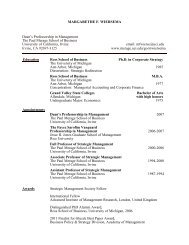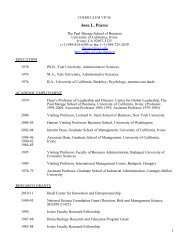View Carlson-Titman-Tiu Paper - The Paul Merage School of Business
View Carlson-Titman-Tiu Paper - The Paul Merage School of Business
View Carlson-Titman-Tiu Paper - The Paul Merage School of Business
Create successful ePaper yourself
Turn your PDF publications into a flip-book with our unique Google optimized e-Paper software.
<strong>The</strong> value <strong>of</strong> an asset is the sum <strong>of</strong> discounted cash flows until the first time the asset switches<br />
its type (to type j = i), minus the transaction costs necessary to switch type, plus the discounted<br />
value <strong>of</strong> that asset after the switch. Denoting by θ the first time where a switch occurs for an asset<br />
<strong>of</strong> type i, the value V i <strong>of</strong> that asset will be:<br />
V i (r, L)<br />
θ<br />
= sup E 0 e− t<br />
0 Rs(Is)dsLtdt − e− θ<br />
0 Rs(Is)dsci, jLθ + e− θ<br />
0 Rs(Is)dsV Iθ(rθ, Lθ) <br />
r0 = r, L0 = L .<br />
Before considering equilibrium behavior, we clarify how the value functions V i , which represent<br />
the discounted value <strong>of</strong> cash flows produced by assets currently held in private (i = P ) or public<br />
(i = R) form, differ from the observed prices paid for real estate assets when they change hands.<br />
This distinction depends on both the level <strong>of</strong> transaction costs as well as which party, purchaser<br />
or seller, incurs the costs. We take the view that it is costly for REITs to access capital markets<br />
when transferring funds to or from investors, for example due to the cost <strong>of</strong> issuing trust units.<br />
Under this assumption, the real estate price will represent the proceeds transferred from/to the<br />
private buyer/seller. In equilibrium, therefore, all real estate transaction prices will reflect private<br />
valuations and REITs will trade at a premium or discount to these values. Under our assumption<br />
<strong>of</strong> zero transaction costs for asset sales between private parties, the observed real estate prices<br />
associated with such transactions will be V P (r, L) in equilibrium. Thus, regardless <strong>of</strong> the parties<br />
involved in a real estate transaction, prices in our model will always reflect private valuations.<br />
3.3 <strong>The</strong> Equilibrium<br />
An equilibrium in our model consists <strong>of</strong> return processes for publicly held real estate, rt, and<br />
privately held real estate, r ∗ , and associated capital flows to and from the private sector. We do<br />
not explicitly model the capital flows and instead characterize the general form <strong>of</strong> the flows and<br />
their impact on REIT prices and discount rates in the following <strong>The</strong>orem.<br />
<strong>The</strong>orem 1 Let V P the value <strong>of</strong> the privately held asset and V R that <strong>of</strong> the publicly held asset.<br />
<strong>The</strong>n the value function V P and V R satisfy:<br />
7<br />
(5)






